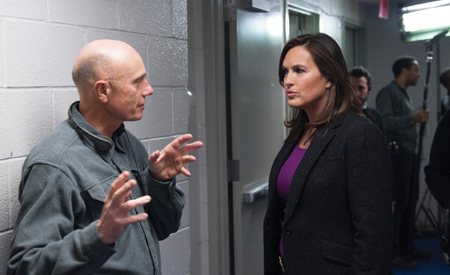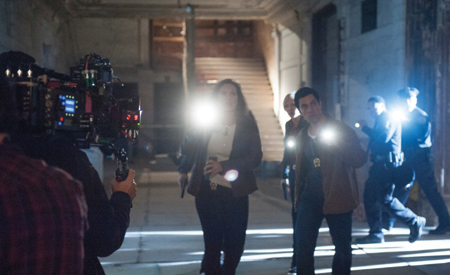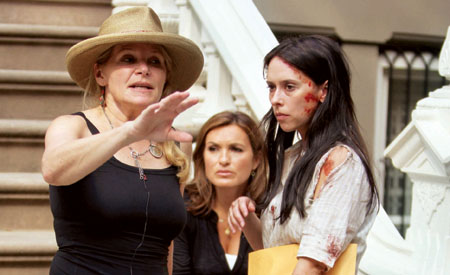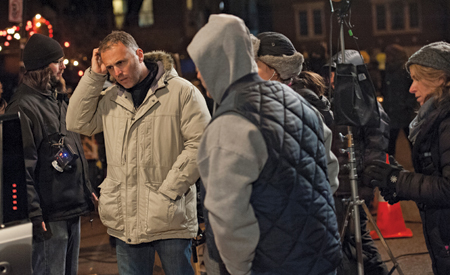By Ann Farmer
 In over 300 episodes, more than 30 directors have been keeping SVU's gritty plots exciting and emotionally reasonant. (above) Jean de Segonzac, with show's star Mariska Hargitay, says he still gets excited when he's prepping an episode.
In over 300 episodes, more than 30 directors have been keeping SVU's gritty plots exciting and emotionally reasonant. (above) Jean de Segonzac, with show's star Mariska Hargitay, says he still gets excited when he's prepping an episode.
Director Jean de Segonzac could have used heavy makeup, retro clothing and a soft-focused lens to make actress Mariska Hargitay look younger in the 300th episode of Law & Order: Special Victims Unit. But that would have been too easy.
The episode, titled “Manhattan Vigil,” has Hargitay’s character, Detective Olivia Benson, experiencing flashbacks to a fictional kidnapping investigation 13 years earlier that never actually appeared in the series. Rather than deploy artifice to make Hargitay look thirteen years younger, de Segonzac decided to do something more experimental. He seamlessly matched current scenes of Hargitay with old footage of her from the series’ initial season in 1999, including the pilot, which he directed, so it appeared as if Detective Benson was revisiting a real SVU case.
The ploy packed a satisfying sentimental jolt. Longtime viewers could see Hargitay in the first blush of playing her character (she looked like an ingenue cop) juxtaposed with shots of her now seasoned, been-around-the-block detective. “I hoped people wouldn’t notice that it was filmed in completely different parts of the city,” says de Segonzac, who combed through the old footage for shots that blended with the new material.
“What I bring to the set,” says de Segonzac, who’s directed 18 episodes of SVU, “is my boyish enthusiasm. I can’t help but be thrilled and excited as all the preparation falls into place.” Directing SVU’s milestone 300th episode, he says, “underscored the importance of keeping it fresh, urgent and real.”
Now in its 14th season, SVU is the longest running and probably darkest of the Law & Order franchise due to its focus on heinous sex crimes culled from real events. Along the way more than 30 directors have been responsible for keeping SVU’s gritty plots visually exciting and emotionally resonate, including Peter Leto, Helen Shaver, and last season, Michael Slovis and Michael Smith. “A lot of people tune in because it’s like comfort food to them,” says Leto, “but you still need to push the boundaries.”
For a man who insists that he’s “terrified of the police,” de Segonzac has forged a vigorous career of directing police procedurals. He has also directed many other genres, including Battlestar Galactica, Damages, Gossip Girl, and In Treatment. But the majority of his directing for the past 15 years (partly due to his desire to stick close to home in New York) has been for Dick Wolf creations. He’s directed over 60 episodes of the original Law & Order and its spinoffs. He’s trotted several of them out of the starting gate, including Law & Order: Criminal Intent, Law & Order: Trial by Jury and L.A. Dragnet.
“The first one is challenging,” he says, referring to the particulars of directing pilots. “It’s the first one where you try out the actors and you set the tone for the first time.” He’s also impacted the SVU series in less serious ways; Hargitay chuckles about how from the start he referred to certain scenes as “holy mackerel moments.” She says, “That caught on,” explaining that she and former co-star Christopher Meloni plundered the term for comic relief countless times over the years.
Part of what distinguishes de Segonzac from other cop show directors is his expertise as a cameraman. He began his career as a documentary and feature film cinematographer shooting in the cinema verite style. He shot and co-directed Road Scholar, a wry journey across America with PBS journalist Andrei Codrescu, which won a 1995 Peabody Award. Around that same time he also made a strong contribution as DP during the first season of Homicide: Life on the Street. De Segonzac shot 53 episodes of the series and directed six of them, thus initiating his career trajectory in law enforcement dramas.

De Segonzac still has a keen sense of composition. “It just comes with Jean,” shrugs executive producer Warren Leight. “With Jean the camera is always organic, never forced. He has a great sense of action and knows what to look at when he’s directing. He’s cutting it in his head while he’s shooting. And he’s crisp. Some directors shoot, and shoot and shoot. It’s like baseball: when the pitcher doesn’t take a lot of time between pitches, the whole team plays better.”
Like most TV series, SVU directors can’t afford to waste a minute. They have eight days to prep and eight days to shoot, covering 8-10 script pages a day. Leight, who took over as showrunner last year, prefers directors to commit to three or four episodes a season. “When there’s too many singletons,” says Leight, “it wears people down.” At the same time, too much recycling of the same directors is not ideal. A new director, for instance, might suggest a novel placement for a camera. “And we realize that in all the episodes before this one, no one put the camera there before.”
Together with co-executive producer Smith, Leight chooses directors with strong technical chops who can work collaboratively, and are adept at finding the right visual language to tell that particular story. “The solution that worked last week won’t work this week,” he says.
Directors must also know how to communicate with actors new to the show. In addition to the regular cast, SVU invites a number of high-profile guest stars each season to play victims, perps and other characters. “You can’t dictate a performance. You can’t demand a performance. A performance is always given,” says Shaver, who recalls working with Morgan Fairchild, Jaclyn Smith and 1960s icon Ann-Margret as a creepy murder suspect in an episode called “Bedtime.”
Ann-Margret would call Shaver each night to discuss her motivation for her next day’s lines. “She was not in any way embarrassed to ask and explore,” says Shaver, a former actress who recognizes that actors need to feel safe when plumbing their character’s psyche, especially when playing unsettling characters. “I don’t ever have to tell an actor that I understand,” says Shaver. “I do.”
“As the director,” she says, “you come with a plan and the ability to see what is. And you make adjustments so you’re not trying to shove a round peg into square hole.” When Jennifer Love-Hewitt agreed to play a serial rape victim who had subsequently become severely withdrawn, Shaver told her, “I invite you to do the role without any makeup. I invite you to wash your face and come to work.” Hewitt agreed and her performance was critically acclaimed.
Smith, who shifted to SVU after directing lighter shows such as White Collar and Burn Notice, has adapted his directing skills to the darker material. “You have to be extremely sensitive, not only to the viewer, but to the victims out there who are watching.” While recently directing a rape scene involving a woman and two men, he closed the set to everyone except essential crew. “If [the actor] isn’t comfortable showing certain parts of her body,” says Smith, “I’ll use a stunt double, or cover her. If possible, I like to do it straight through without a stop and start. We don’t need to rehearse it perfectly.”
De Segonzac says he’s not bothered by the discomfiting stories and often despicable characters portrayed. “I do like the darker side of things, the disturbing image,” he says. One episode of the original Law & Order, however, hit too close to home. In 2007, he was faced with the uncomfortable job of directing “Melting Pot,” an episode based on the actual murder of New York actress Adrienne Shelly, whom he had worked with years earlier shooting an episode of Homicide. “You are handed a script and there is nothing you can do about it,” says de Segonzac. “You parachute in.”
Despite the somber subjects, SVU is “one of the most joyous places to work,” says Slovis, another director who started his career as a cinematographer. He has alternately worked as a director and a cinematographer on Breaking Bad and 30 Rock. He says it’s especially satisfying to work with Hargitay, who remains thoroughly committed. When she feels a need for a retake, she won’t hesitate to give the directors a swirly motion with her forefinger. “Her enthusiasm after 14 years,” says Slovis, “is infectious and incredible.”
Another steady player in the series is New York City in all its glory and tawdriness. To emphasize the rawness and believability of the crime stories, the directors devote half their shooting schedules to locations throughout the city. “Today I was scouting for bars and streets in Hunts Point [Bronx], where prostitutes pick up johns,” says Smith, who was also looking for a church and a spot where “somebody might dump a body.” His aim was to find locations in close proximity in order to lessen the crew’s travel and setup time.
Location shooting, though, comes with its own set of variables. For Smith’s first SVU episode, featuring Harry Connick, Jr., it was five degrees outside with gusting winds. “I didn’t want the audience to notice the actors shivering,” says Smith. So he skipped rehearsals and went right to the first take. While prepping for this season’s opener, Slovis was thrilled to discover a location under the FDR Drive in Manhattan, sandwiched between the Manhattan and Brooklyn Bridges. “It was a huge panoramic shot, but it felt secretive,” says Slovis. During the shoot, however, “hundreds of cars a minute were running overhead. I can’t tell you how loud it was.”
SVU is also noted for its action sequences. “It’s called motion pictures, not standing around and talking pictures. I took that to heart,” says Leto, recalling a favorite interrogation room scene he directed with Carol Burnett. To liven up what could have been a very flat scene, Leto kept shifting his camera positions. Sometimes he contrasted whip pans with extreme close-ups of eyes and mouths. Whenever he directs, he tries to vary the shots to keep things interesting. “You build, then lull, and then build higher,” he says. “It’s like music. The lulls are moments to breathe and take in what’s been said. If you’re always moving quickly, it all looks the same. But if you suddenly put the breaks on, it catches peoples’ attention.”

(above) Helen Shaver invited guest star Jennifer Love Hewitt to play the role of a serial rape victimwithout any makeup. "You can't dicatate a performance; a performance is given." (below) Peter Leto, with Hargitay and Sharon Stone (left) says, "It's called motion pictures, not standing still and talking pictures. I took that to heart."

As SVU’s showrunner, Leight oversees many decisions, but he never discusses camera positions with the directors. At the tone meetings, which take place during the prep stage and involve the director and department heads, Leight discusses the script’s backstory and other concerns like theme, character and psychology. “But not camera,” he says. “I might say, ‘Do me a favor and make sure we have coverage in this scene,’ to ensure they get certain reaction shots.”
Leight also likes the episode’s opening vignette, known as the teaser, to feel like a self-contained short film. One of Shaver’s teasers, for the episode “Dirty,” unwound like one long mesmerizing shot. The camera followed a mysterious woman as she left her office, got into her car and drove to a location where a body falls off the roof of a building onto her car’s roof. The viewers are given only tantalizing glimpses of the woman: a sliver of her cheek or her legs as she walks down the hall. “It’s to make the audience want to follow her,” says Shaver.
De Segonzac wanted a similarly breathless quality for the teaser for the 300th episode. “This is a very, very heartfelt script,” he says. He begins the teaser with flashbacks to the first kidnapping 13 years ago. The mother is posting signs of her missing son. The image dissolves to a year later: She is still praying for his return, kneeling beside a street mural dedicated to his memory. As the story gradually catches up to the present, a couple and their son (who will later be abducted) are walking past the same mural.
The camerawork, meanwhile, steadily accelerates the pace. Agitated blocking and fast cuts increase the intensity. A subtle foreboding sets in. “That’s the idea,” says de Segonzac. “Keep it moving like a shark, or it will die. My job is to translate the written scenes into vivid, real moments, keeping up the momentum and the urgency without losing the story’s thread.”
As the teaser builds to its climax, the son is suddenly spirited away from his father and ushered into a closing subway car. The dad races up the station steps for help. The camera swirls around him as he frantically calls the police, as though he were in the eye of a tornado, emphasizing his confused and distraught state.
De Segonzac is shooting on location on a sweltering October day. More than a dozen other cast and crew are squeezed into the dining room of a tiny apartment in a Bronx housing project. Except for the actors, everyone is plastered against the walls. 1st AD Amanda Slater instructs several hefty men to remove chairs, shift a credenza, and raise a table onto blocks to accommodate de Segonzac’s upcoming shots. To add to everyone’s discomfort, a bus pulls up and stops outside the window and is audibly idling for a long time, delaying the shooting. “Why didn’t anybody tell me there was a bus stop?” de Segonzac says to no one in particular.
He turns his attention to the actress playing the mother of the first missing boy, helping her find the bitterness and anger her character feels toward the police for failing to find her son. He tells her to slam shut the family album that she’s showing Detective Benson, then press it close to her chest. “This is something precious,” he says, and instructs her to walk toward a framed photo of her son.
“Now I’m going to play camera,” de Segonzac says. He generally starts each scene by creating a moving master, one long take that tells the entire story. As the actors walk through the scene, he looks through his viewfinder and moves the way he will shoot it: crouching low at times and raising up, panning from one face to the other, moving closer and pulling back. Lithe and agile, he seems to have an endless reservoir of energy.
“When taking the camera,” he explains, “I’m in the trenches with [the actors]. We’re doing a ballet together. It brings up a level of excitement and intensity. I find new things. I realize if I go this way, I create this situation. Then I re-block it. I’m not locked into hitting marks. Whole shots can fail because actor or camera don’t make their mark. This way I keep it rolling.”
 (above) Director-producer Michael Smith, who moved to SVU in 2012 after directing lighter shows, says he has to adapt his style for the darker material. (below) De Segonzac likes to shoot close ups first when the actor is fresh, and rarely pauses between takes
(above) Director-producer Michael Smith, who moved to SVU in 2012 after directing lighter shows, says he has to adapt his style for the darker material. (below) De Segonzac likes to shoot close ups first when the actor is fresh, and rarely pauses between takesDe Segonzac never retreats to the video village. “If you’re in the room,” he says, “you can better feel what’s being delivered by the actors.”
Unlike other directors, who tend to follow up their moving masters with wide shots and then close-ups, de Segonzac prefers to nab the close-ups right away. “They’re going to be best on the first take,” he says. He doesn’t always reveal who he’s going to be aiming his camera at. “Because then everybody is forced to be on.” And he doesn’t like too much rehearsing because the material can get stale. In fact, he likes to shoot rehearsals. “People get annoyed,” he says, “but they are more off-guard, less studied.”
After the next take he yells, “Cut! It’s too controlled, too self-contained,” he tells the actress playing the mother. Trying to rile her up against the detectives, he tells her, “They’re setting up your hopes.” This time he likes what he sees. “Cut, cut, cut! Nice job,” he says to her enthusiastically. “We go right away! I do a take all on her. Then I do you,” he says, turning to Hargitay, who laughs. “When you get that crazy look in your eye,” she tells him, “I know it’s going to be okay.”
De Segonzac never pauses long, which suits Hargitay. “Between takes,” she says, “that’s when things fall apart. All he cares about is making it better. And that’s why I trust him. He stays in there till he gets it. He’ll do anything for the shot.”
Several weeks later, when the cast and crew gather at a Manhattan club to celebrate the milestone episode, Leight jumps up during the teaser and shouts, “Jeanny D gets the guns out!” ‘Jeanny D’ is how friends and colleagues affectionately refer to de Segonzac.
Even his fellow directors admire what de Segonzac brings to the SVU experience. “His visual storytelling is unparalleled,” says Slovis. “His oneness with the camera and how he finds the essence of a scene with his camera is unsurpassed. His camera is always in the right spot.”